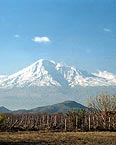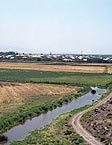|

|
Right
of the main highway is
Pokr
Vedi (also
Vedi Nerkin), first village in the old mahal of Vedi Basar. |
|
The
road through Pokr (Little) Vedi is signposted for Khor Virap.
The left fork beyond Pokr Vedi leads to the village of Lusarat
(till 1968 Khor Virap or
Shikhlar), with a conspicuous statue of one of the early 20th
c. fidayi, nationalist fighters against the Turks. Take
the right fork and drive past the extensive
cemetery to the monastery
of Khor Virap
("deep pit"), built on |

|
|
|
|
the side
of
one of a chain of low hills looking out across the
Russian-guarded border to Turkey and Mt. Ararat.
The central church, S. Astvatsatsin, dates from the end
of the 17th c. The
smaller S. Gevorg church was originally constructed in 642 by
Katholikos Nerses the Builder, but has been repeatedly rebuilt.
In this second church are two deep stone cisterns, the
further of which, then garnished with serpents (or alternatively
poisonous insects), is said to have been the pit in which
Gregory the Illuminator was imprisoned for 13 years by the cruel
king Trdat (Tiridates) III (or maybe IV – the chronology set
forth by the ancient Armenian sources makes no sense without
finding another Trdat the ancients left out). The descent into
the pit, now via a perilous metal stairway, is spiritually
rewarding and generally not fatal. Nerses
the Builder is supposed to be buried in Khor Virap, along with
relics of Gregory himself.
Khor Virap was an important educational center in
medieval times. Abandoned in late Persian times, it was rein habited by three
monks from Ejmiatsin after the Russian conquest.
It remains a pilgrimage site and place for wedding photos
and sheep sacrifice up to the present day. The
hill of Khor Virap and those adjoining were the site of the
important early Armenian capital city of ancient
Artashat or Artaxiasata,
built by King Artashes I, founder of the Artashesid dynasty,
around 180 BC. This dynasty was an offshoot of the Parthian royal house,
reflecting Armenia's status then as Parthian protectorate. According to legend, the Carthaginian general Hannibal,
who spent his twilight years in flight from a vengeful Rome,
chose the site and inspired the founding of the city. Though well-known in literary sources, Artashat remained
long-undiscovered, archaeologists misled by its ancient
description as a spacious and well-laid-out city located at the
confluence of the Araxes and Metsamor rivers. The course of the
rivers has changed, and that confluence is now 20-odd km further
N of the city site. On
the upper slopes of the hills, extensive excavations have
revealed the foundations of residential and other structures,
along with Mediterranean-style art and other traces of a rich
Hellenizing culture. Short
stretches of well-preserved mud-brick fortifications line the N
slope of the third hill from the NE.
Ancient coins and potsherds can still be found, showing
links with the whole ancient world. Armenia's capital was moved
to Dvin by King Khosrov III (330-338), partly because of the
increasingly unhealthy swamps nearby. |